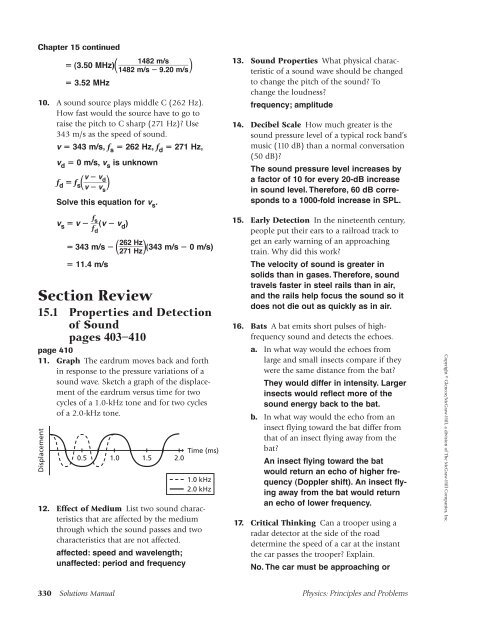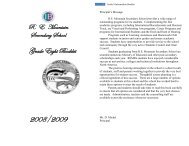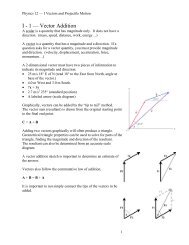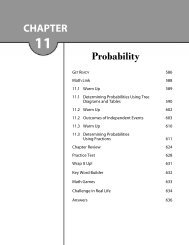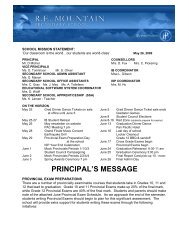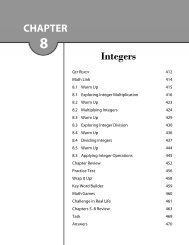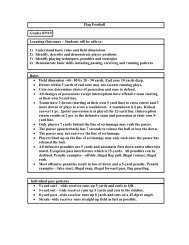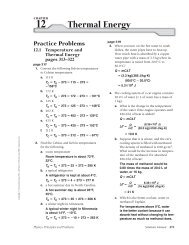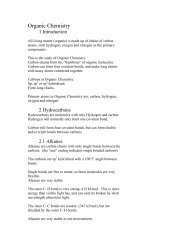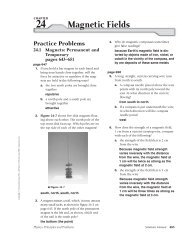Physics Solutions Manual
Physics Solutions Manual
Physics Solutions Manual
You also want an ePaper? Increase the reach of your titles
YUMPU automatically turns print PDFs into web optimized ePapers that Google loves.
Chapter 15 continued<br />
1482 m/s<br />
(3.50 MHz) 1482 m/s 9.20 m/s<br />
3.52 MHz<br />
10. A sound source plays middle C (262 Hz).<br />
How fast would the source have to go to<br />
raise the pitch to C sharp (271 Hz)? Use<br />
343 m/s as the speed of sound.<br />
v 343 m/s, f s 262 Hz, f d 271 Hz,<br />
v d 0 m/s, v s is unknown<br />
d <br />
s<br />
fd fsv v<br />
v v<br />
Solve this equation for v s .<br />
fs<br />
vs v (v vd )<br />
f<br />
d<br />
343 m/s 2 62<br />
Hz<br />
(343 m/s 0 m/s)<br />
271<br />
Hz<br />
11.4 m/s<br />
Section Review<br />
15.1 Properties and Detection<br />
of Sound<br />
pages 403–410<br />
page 410<br />
11. Graph The eardrum moves back and forth<br />
in response to the pressure variations of a<br />
sound wave. Sketch a graph of the displacement<br />
of the eardrum versus time for two<br />
cycles of a 1.0-kHz tone and for two cycles<br />
of a 2.0-kHz tone.<br />
Displacement<br />
Time (ms)<br />
0.5 1.0 1.5 2.0<br />
12. Effect of Medium List two sound characteristics<br />
that are affected by the medium<br />
through which the sound passes and two<br />
characteristics that are not affected.<br />
affected: speed and wavelength;<br />
unaffected: period and frequency<br />
1.0 kHz<br />
2.0 kHz<br />
13. Sound Properties What physical characteristic<br />
of a sound wave should be changed<br />
to change the pitch of the sound? To<br />
change the loudness?<br />
frequency; amplitude<br />
14. Decibel Scale How much greater is the<br />
sound pressure level of a typical rock band’s<br />
music (110 dB) than a normal conversation<br />
(50 dB)?<br />
The sound pressure level increases by<br />
a factor of 10 for every 20-dB increase<br />
in sound level. Therefore, 60 dB corresponds<br />
to a 1000-fold increase in SPL.<br />
15. Early Detection In the nineteenth century,<br />
people put their ears to a railroad track to<br />
get an early warning of an approaching<br />
train. Why did this work?<br />
The velocity of sound is greater in<br />
solids than in gases. Therefore, sound<br />
travels faster in steel rails than in air,<br />
and the rails help focus the sound so it<br />
does not die out as quickly as in air.<br />
16. Bats A bat emits short pulses of highfrequency<br />
sound and detects the echoes.<br />
a. In what way would the echoes from<br />
large and small insects compare if they<br />
were the same distance from the bat?<br />
They would differ in intensity. Larger<br />
insects would reflect more of the<br />
sound energy back to the bat.<br />
b. In what way would the echo from an<br />
insect flying toward the bat differ from<br />
that of an insect flying away from the<br />
bat?<br />
An insect flying toward the bat<br />
would return an echo of higher frequency<br />
(Doppler shift). An insect flying<br />
away from the bat would return<br />
an echo of lower frequency.<br />
17. Critical Thinking Can a trooper using a<br />
radar detector at the side of the road<br />
determine the speed of a car at the instant<br />
the car passes the trooper? Explain.<br />
No. The car must be approaching or<br />
330 <strong>Solutions</strong> <strong>Manual</strong> <strong>Physics</strong>: Principles and Problems<br />
Copyright © Glencoe/McGraw-Hill, a division of The McGraw-Hill Companies, Inc.


